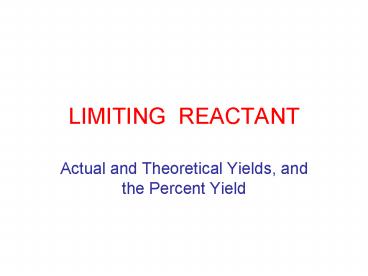LIMITING REACTANT PowerPoint PPT Presentation
1 / 14
Title: LIMITING REACTANT
1
LIMITING REACTANT
- Actual and Theoretical Yields, and the Percent
Yield
2
LIMITING REACTANT
- IMPORTANCE
- Calculations of limiting reactant, theoretical
and percent yield are central to chemistry
because they bring quantitative understanding to
chemical reactions - These calculations are used in both, General and
Organic Chemistry
3
LIMITING REACTANT LESSON PLAN
- OBJECTIVES
- Acquire the skills necessary to recognize a
limiting reactant problem - Definitions
- Three methods used to determine the limiting
reactant - Theoretical yield and the percent yield
calculations
4
DEFINITIONS
- LIMITING REACTANT
- Completely consumed in a chemical reaction
- Determines the amount of product formed
- The reactant that produces the least amount of
product
5
DEFINITIONS
- THEORETICAL YIELD
- The amount of product that can be made based on
the amount of the limiting reactant - ACTUAL YIELD
- The amount of product actually or experimentally
produced - THE PERCENT YIELD
- yield (actual/theoretical)x100
6
METHODS USED TO DETERMINE THE LIMITING REACTANT
- Calculate the moles needed of each reactant and
compare with the moles given - II. Divide the moles of each reactant by its
stoichiometric coefficient and then compare them - Calculate the moles of product produced by each
reactant and compare them
7
Limiting Reactant
- 1N2(g) 3H2(g) ? 2NH3(g)
- Given 3.0 mole 6.0 mole
- I. Calculate the amount of reactant needed
- 3.0 mol N2 x 3mol H2 9.0 mol H2 needed
- 1mol N2
- 6.0 mole H2 given lt 9.0 mol H2needed
- H2 is the Limiting Reactant
8
Limiting Reactant
- 1N2(g) 3H2(g) ? 2NH3(g)
- Given 3.0 mole 6.0 mole
- I. Calculate the amount of reactant needed
- 6.0 mol H2 x 1mol N2 2.0 mol N2 needed
- 3mol H2
- 3.0 mole N2 given gt 2.0 mol N2needed
- N2 is in excess H2 is the Limiting Reactant
9
Limiting Reactant
- 1N2(g) 3H2(g) ? 2NH3(g)
- Given 3.0 mole 6.0 mole
- II. Divide the moles of each reactant by its
stoichiometric coefficient - 3.0 mol N2 3.0mol N2 6.0 mol H2
2.0mol H2 - 1.0 mol N2 3.0 mol H2
- The reactant present in smaller
amount is the L.R. ---- H2 (2.0 mol is the
change)
10
Limiting Reactant
- 1N2(g) 3H2(g) ? 2NH3(g)
- Given 3.0 mole 6.0 mole
- III. Calculate the amount of product produced by
each reactant - 3.0 mol N2 x 2 mol NH3 6.0 mol NH3
- 1 mol N2
- 6.0 mol H2 x 2 mol NH3 4.0 mol NH3
(theoretical yield) - 3 mol H2
- The reactant that produces the least amount of
product is the L.R.------- H2
11
Excess Reactant
- How much of the excess reactant reacted and how
much is left unreacted? - 1N2(g) 3H2(g) ? 2NH3(g)
- Given 3.0 mole 6.0 mole
- 6.0 mol H2 x 1 mol N2 2.0 mol N2 reacted
- 3 mol H2
- Unreacted N2initial(given) reacted
- Unreacted N2 3.0mol - 2.0 mol 1.0 mol N2
12
1N2(g) 3H2(g) ? 2NH3(g)
13
1N2(g) 3H2(g) ? 2NH3(g)
- Initial 3.0 mol 6.0 mol 0.0
mol - Change - 2.0molx1 -2.0molx3 2.0molx2
- - 2.0mol -6.0mol 4.0
mol - Final 1.0 mol 0.0 mol 4.0
mol - excess L.R.
Theoretical yield
14
Percent Yield Calculation
- Knowing that the theoretical yield of ammonia is
4.0 mol and the actual (experimental) yield of
ammonia is 55.38 g, calculate the yield of NH3.
N2(g) 3H2(g) ? 2NH3(g) - 4.0 mol NH3 x 17.00 g NH3 68.00 g NH3
- 1mol NH3
- yield ( 55.38 g/68.00 g)x100 81.44

